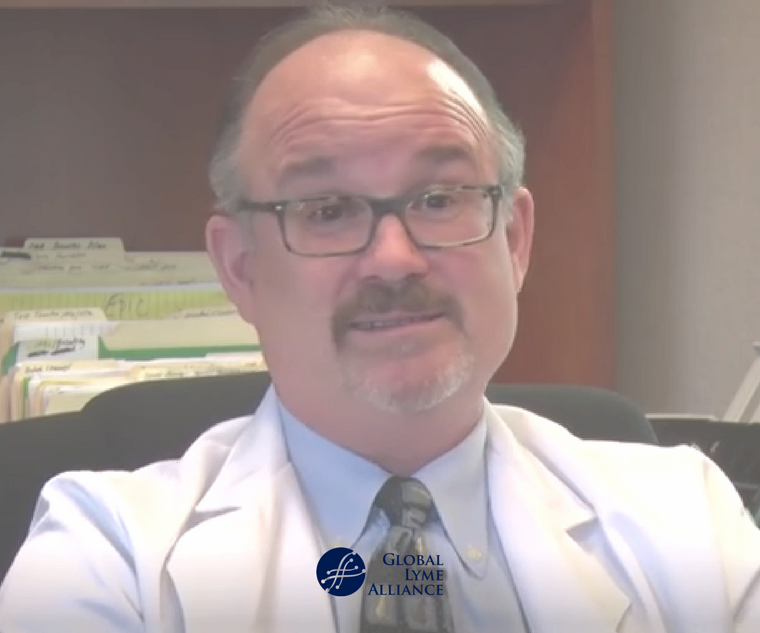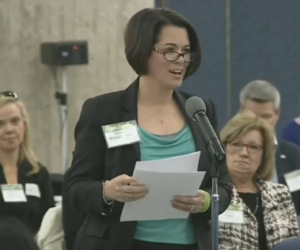
The Tick-Borne Disease Working Group held its first meetings in Washington, D.C. on Monday, Dec. 11, 2017 and Tuesday, Dec. 12, 2017.
History was made earlier last week when the federal Tick-Borne Disease Working Group convened its first public meetings in Washington D.C. and Lyme patients spoke out forcefully and passionately about the urgent need to solve the challenges of Lyme and other tick-borne diseases. The U.S. Department of Health and Human Services advisory group was formally established when Congress approved the 21st Century Cures Act in 2016 to provide subject matter expertise and to review federal efforts related to tick-borne diseases. The committee constitutes the first recognition at the highest level of government that significant work needs to be done to repair what is wrong with the way Lyme disease is diagnosed, treated, researched, counted and controlled. The first day of the two-day inaugural meeting was largely about foundation-building. Members of the 14-member committee introduced themselves and spoke about their resolve to facilitate discussions based on all available evidence, including patient experiences. Tick-Borne Disease Working Group Chair John Aucott, M.D. (pictured)— director of the Johns Hopkins Lyme Disease Clinical Research Center in Maryland and a Global Lyme Alliance 2016-17 grantee—was optimistic about what the working group could accomplish if members all worked together. “This is about bridging perspectives,” he said. Vice Chair Kristen Honey, Ph.D., P.M.P. a Senior Policy Analyst at the White House and Office of Management and Budget, embraced the motto employed by the new U.S. Surgeon General: “better health through better partnerships.” Honey encouraged everyone to “hit reset” and have open minds as members freely share ideas to let transformative change happen. During the proceedings, committee members heard from public health officials, clinicians, government employees and Lyme patients. But what was particularly impressive was that Lyme patients were finally getting an opportunity to speak about the challenges they face. One after the other they spoke about their frustrations and anger because of the scientific and medical community’s lack of compassion and seriousness about their disease. They shared story after story about going from doctor to doctor, suffering from misdiagnoses, searching for solutions, often for years, before they found the doctor who diagnosed their illness. The patients expressed hope that the Working Group’s deliberations and recommendations will finally improve the collective response by federal agencies, including the Centers for Disease Control and Prevention. [caption id="attachment_8539" align="alignleft" width="300"] U.S. Air Force Colonel Nicole Malachowski speaking at the first meeting of the Tick-Borne Disease Working Group[/caption] Among those patients who spoke was U.S. Air Force Colonel Nicole Malachowski, the first female fighter-pilot ever chosen to fly the elite Thunderbirds and who has proudly served our nation for more than 21 years. Her message was electrifying. “I thought I was tough as a combat-proven fighter pilot,” she said, “but tick-borne illness destroyed me, brought me to my knees and ruthlessly broke me.” She saw 20 doctors before she was finally diagnosed and will soon will be permanently retired due to neurological complications resulting from her tick-borne disease. Colonel Malachowski emphasized that she is “deeply concerned” about the impact of tick-borne disease on the military. Another speaker was Olivia Goodreau, a 13-year old Lyme sufferer from Denver, Colorado, who saw 51 doctors and underwent “hundreds of tests that I didn’t need” before she was diagnosed with Lyme disease. She then saw three more doctors before the 54th told her that she also had, in addition to Lyme, several of its related co-infections and other medical conditions, as well. “Fifty three doctors missed everything,” she said. At one point she had been told she had Wilson’s disease, a genetic disorder, and wouldn’t live past the age of 40. When the DNA tests showed she didn’t have Wilson’s disease “I was asked if I was maybe making this up.“ But, she asked the meeting attendees, “what second grader would make up a tremor in her hand, blacking out and not being able to hold up her own head?” Megan DuLaney, who worked for the Department of Defense her entire career, talked about how she became disabled after suffering a heart attack and stroke from long-term undiagnosed Lyme disease. After more than four years of “complete deterioration,” she said, she is unable to work. Another heartbreaking story was shared by 14-year old Caitlyn Fitzgerald, whose mother also suffers from Lyme. Her voice breaking, the teen said she suffers from body and joint pain, headaches, muscle pains, fatigue, and difficulty in school. Although at one point a doctor told her that she was just suffering from “growing pains.” She said she’s still sick and doctors have told her that there is nothing they can do to help her. During the meeting, public comments were facilitated by Dazon Dixon Diallo, the founder and CEO of SisterLove, Inc., a woman’s AIDS and reproductive justice organization. She frequently referred to the skepticism the AIDS crisis was held in and how the ACT UP organization made so much noise that they couldn’t be ignored. She told attendees that Lyme patients need the same level of self-advocacy. Much of the second day was organizational, establishing what the Working Group’s six subcommittees would cover as they worked toward drafting a report, due to be released at the end of 2018. It was particularly refreshing to hear members talk about what needs to be addressed as they aim to identify gaps in research, surveillance and prevention. The six groups will concentrate on (1) vectors, prevention, surveillance; (2) pathogenesis, transmission, treatment; (3) testing and diagnostics; (4) access to care; (5) vaccines and therapeutics; (6) other TBDs and co-infections. Without question it will be an enormous undertaking. Speaking on the second day was Bob Sabatino, who retired as a New York Police Department officer after suffering a wide-range of debilitating medical conditions, including losing the use of his knees and shoulders, as a result of Lyme. He stressed the importance of the Working Group for the entire Lyme community. “This is one of the most unique opportunities I’ve seen happen,” he said. “This is so important for everyone to see. Voicing the hope that so many of us feel, he said “There’s an opportunity to work together. We must keep fighting the fight. There will be a change.” As the second day of meetings adjourned, Dr. Aucott said “Signs of success, we worked together and got a lot accomplished.” GLA wishes the Working Group every success and we will be following its progress every step of the way. The world is watching.
U.S. Air Force Colonel Nicole Malachowski speaking at the first meeting of the Tick-Borne Disease Working Group[/caption] Among those patients who spoke was U.S. Air Force Colonel Nicole Malachowski, the first female fighter-pilot ever chosen to fly the elite Thunderbirds and who has proudly served our nation for more than 21 years. Her message was electrifying. “I thought I was tough as a combat-proven fighter pilot,” she said, “but tick-borne illness destroyed me, brought me to my knees and ruthlessly broke me.” She saw 20 doctors before she was finally diagnosed and will soon will be permanently retired due to neurological complications resulting from her tick-borne disease. Colonel Malachowski emphasized that she is “deeply concerned” about the impact of tick-borne disease on the military. Another speaker was Olivia Goodreau, a 13-year old Lyme sufferer from Denver, Colorado, who saw 51 doctors and underwent “hundreds of tests that I didn’t need” before she was diagnosed with Lyme disease. She then saw three more doctors before the 54th told her that she also had, in addition to Lyme, several of its related co-infections and other medical conditions, as well. “Fifty three doctors missed everything,” she said. At one point she had been told she had Wilson’s disease, a genetic disorder, and wouldn’t live past the age of 40. When the DNA tests showed she didn’t have Wilson’s disease “I was asked if I was maybe making this up.“ But, she asked the meeting attendees, “what second grader would make up a tremor in her hand, blacking out and not being able to hold up her own head?” Megan DuLaney, who worked for the Department of Defense her entire career, talked about how she became disabled after suffering a heart attack and stroke from long-term undiagnosed Lyme disease. After more than four years of “complete deterioration,” she said, she is unable to work. Another heartbreaking story was shared by 14-year old Caitlyn Fitzgerald, whose mother also suffers from Lyme. Her voice breaking, the teen said she suffers from body and joint pain, headaches, muscle pains, fatigue, and difficulty in school. Although at one point a doctor told her that she was just suffering from “growing pains.” She said she’s still sick and doctors have told her that there is nothing they can do to help her. During the meeting, public comments were facilitated by Dazon Dixon Diallo, the founder and CEO of SisterLove, Inc., a woman’s AIDS and reproductive justice organization. She frequently referred to the skepticism the AIDS crisis was held in and how the ACT UP organization made so much noise that they couldn’t be ignored. She told attendees that Lyme patients need the same level of self-advocacy. Much of the second day was organizational, establishing what the Working Group’s six subcommittees would cover as they worked toward drafting a report, due to be released at the end of 2018. It was particularly refreshing to hear members talk about what needs to be addressed as they aim to identify gaps in research, surveillance and prevention. The six groups will concentrate on (1) vectors, prevention, surveillance; (2) pathogenesis, transmission, treatment; (3) testing and diagnostics; (4) access to care; (5) vaccines and therapeutics; (6) other TBDs and co-infections. Without question it will be an enormous undertaking. Speaking on the second day was Bob Sabatino, who retired as a New York Police Department officer after suffering a wide-range of debilitating medical conditions, including losing the use of his knees and shoulders, as a result of Lyme. He stressed the importance of the Working Group for the entire Lyme community. “This is one of the most unique opportunities I’ve seen happen,” he said. “This is so important for everyone to see. Voicing the hope that so many of us feel, he said “There’s an opportunity to work together. We must keep fighting the fight. There will be a change.” As the second day of meetings adjourned, Dr. Aucott said “Signs of success, we worked together and got a lot accomplished.” GLA wishes the Working Group every success and we will be following its progress every step of the way. The world is watching.







-2.jpg)